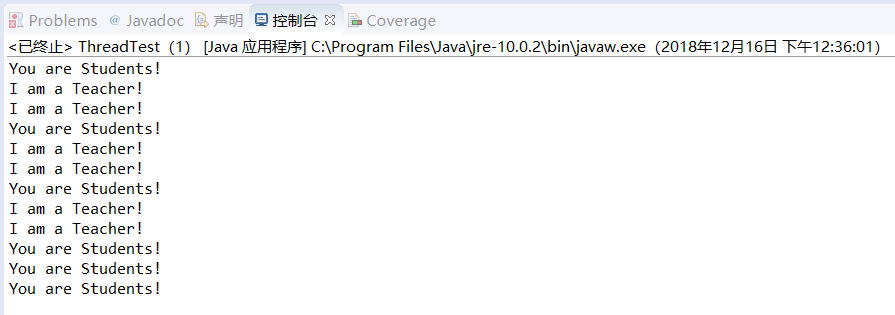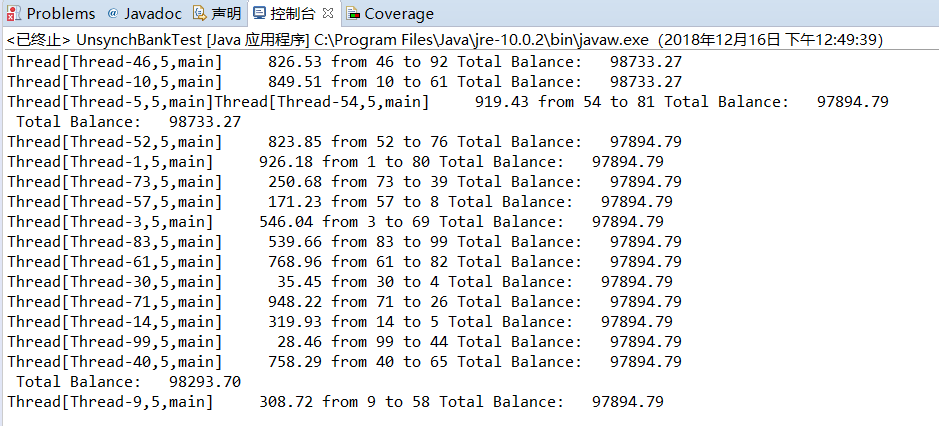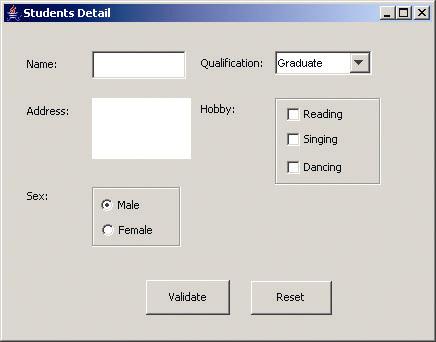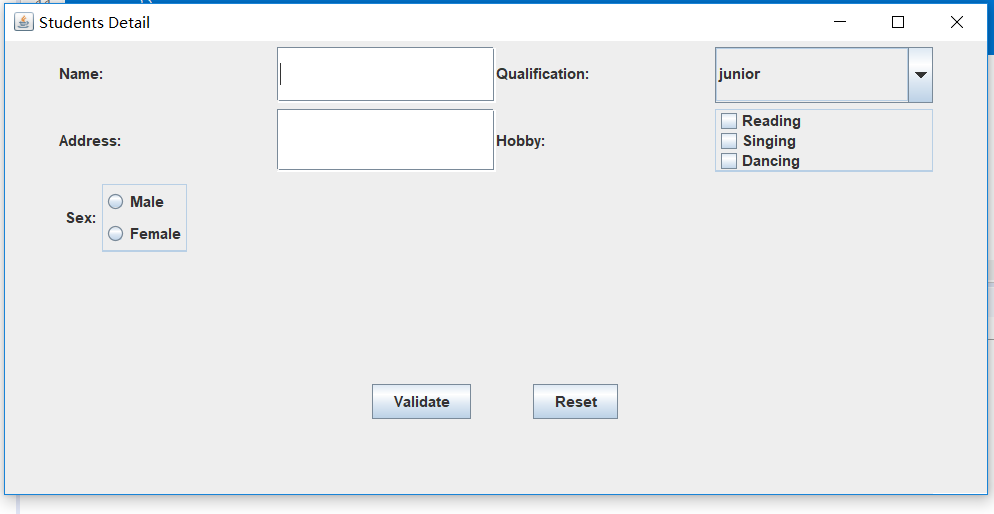201771010108 -韓臘梅-第十六週學習總結
第十六週總結
一、知識總結
1.建立執行緒的2種方法
方式1:繼承java.lang.Thread類,並覆蓋run()方法。優勢:編寫簡單;劣勢:無法繼承其他父類
方式2:實現java.lang.Runnable介面,並實現run()方法。優勢:可以繼承其他類,多執行緒可以共享同一個Thread物件;劣勢:程式設計方式稍微複雜,如需訪問當前執行緒,需呼叫Thread.currentThread()方法
2. Java建立執行緒後,呼叫start()方法和run()的區別
兩種方法的區別
1) start:
用start方法來啟動執行緒,真正實現了多執行緒執行,這時無需等待run方法體程式碼執行完畢而直接繼續執行下面的程式碼。通過呼叫Thread類的start()方法來啟動一個執行緒,這時此執行緒處於就緒(可執行)狀態,並沒有執行,一旦得到cpu時間片,就開始執行run()方法,這裡方法run()稱為執行緒體,它包含了要執行的這個執行緒的內容,Run方法執行結束,此執行緒隨即終止。
2) run:
run()方法只是類的一個普通方法而已,如果直接呼叫run方法,程式中依然只有主執行緒這一個執行緒,其程式執行路徑還是隻有一條,還是要順序執行,還是要等待
run方法體執行完畢後才可繼續執行下面的程式碼,這樣就沒有達到寫執行緒的目的。
總結:呼叫start方法方可啟動執行緒,而run方法只是thread的一個普通方法呼叫,還是在主執行緒裡執行。
這兩個方法應該都比較熟悉,把需要並行處理的程式碼放在run()方法中,start()方法啟動執行緒將自動呼叫 run()方法,這是由jvm的記憶體機制規定的。並且run()方法必須是public訪問許可權,返回值型別為void。
兩種方式的比較 :
實際中往往採用實現Runable介面,一方面因為java只支援單繼承,繼承了Thread類就無法再繼續繼承其它類,而且Runable介面只有一個run方法;另一方面通過結果可以看出實現Runable接口才是真正的多執行緒。
3.執行緒的生命週期
執行緒是一個動態執行的過程,它也有一個從生產到死亡的過程。
(1)生命週期的五種狀態
新建(new Thread)
當建立Thread類的一個例項(物件)時,此執行緒進入新建狀態(未被啟動)。
例如:Thread t1 = new Threade();
就緒(runnable)
執行緒已經被啟動(start),正在等待分配CPU時間片,也就是說此事執行緒正在就緒佇列中排隊等候得到CPU資源。
例如:t1.start();
執行(running)
執行緒獲得cpuz資源正在執行任務(run()方法),此時除非執行緒自動放棄CPU資源或者有優先順序更高的的執行緒進入,執行緒將一直執行到結束!
死亡(dead)
當執行緒執行完畢或被其它執行緒殺死,執行緒就進入死亡狀態,這時執行緒不可能再進入就緒狀態等待執行。
自然終止:正常執行run()方法後終止
異常終止:呼叫stop()方法讓一個執行緒終止執行
堵塞(blocked)
由於某種原因導致正在執行的執行緒讓出CPU並暫停自己的執行,即進入堵塞狀態。
正在睡眠:用sleep(long t) 方法可使執行緒進入睡眠方式。一個睡眠著的執行緒在指定的時間過去可進入就緒狀態。
正在等待:呼叫wait()方法。(呼叫notify()方法回到就緒狀態)
被另一個執行緒所阻塞:呼叫suspend()方法。(呼叫resume()方法恢復)
5.如何實現執行緒同步?
當多個執行緒訪問同一個資料時,容易出現執行緒安全問題,需要某種方式來確保資源在某一時刻只被一個執行緒使用。需要讓執行緒同步,保證資料安全
執行緒同步的實現方案:同步程式碼塊和同步方法,均需要使用synchronized關鍵字
執行緒同步的好處:解決了執行緒安全問題
執行緒同步的缺點:效能下降,可能會帶來死鎖
6. 關於同步鎖的更多細節
Java中每個物件都有一個內建鎖。
當程式執行到非靜態的synchronized同步方法上時,自動獲得與正在執行程式碼類的當前例項(this例項)有關的鎖。獲得一個物件的鎖也稱為獲取鎖、鎖定物件、在物件上鎖定或在物件上同步。
當程式執行到synchronized同步方法或程式碼塊時才該物件鎖才起作用。
一個物件只有一個鎖。所以,如果一個執行緒獲得該鎖,就沒有其他執行緒可以獲得鎖,直到第一個執行緒釋放(或返回)鎖。這也意味著任何其他執行緒都不能進入該物件上的synchronized方法或程式碼塊,直到該鎖被釋放。
釋放鎖是指持鎖執行緒退出了synchronized同步方法或程式碼塊。
關於鎖和同步,有一下幾個要點:
1)、只能同步方法,而不能同步變數和類;
2)、每個物件只有一個鎖;當提到同步時,應該清楚在什麼上同步?也就是說,在哪個物件上同步?
3)、不必同步類中所有的方法,類可以同時擁有同步和非同步方法。
4)、如果兩個執行緒要執行一個類中的synchronized方法,並且兩個執行緒使用相同的例項來呼叫方法,那麼一次只能有一個執行緒能夠執行方法,另一個需要等待,直到鎖被釋放。也就是說:如果一個執行緒在物件上獲得一個鎖,就沒有任何其他執行緒可以進入(該物件的)類中的任何一個同步方法。
5)、如果執行緒擁有同步和非同步方法,則非同步方法可以被多個執行緒自由訪問而不受鎖的限制。
6)、執行緒睡眠時,它所持的任何鎖都不會釋放。
7)、執行緒可以獲得多個鎖。比如,在一個物件的同步方法裡面呼叫另外一個物件的同步方法,則獲取了兩個物件的同步鎖。
8)、同步損害併發性,應該儘可能縮小同步範圍。同步不但可以同步整個方法,還可以同步方法中一部分程式碼塊。
9)、在使用同步程式碼塊時候,應該指定在哪個物件上同步,也就是說要獲取哪個物件的鎖。例如:
public int fix(int y) {
synchronized (this) {
x = x - y;
}
return x;
}
當然,同步方法也可以改寫為非同步方法,但功能完全一樣的,例如:
public synchronized int getX() {
return x++;
}
與
public int getX() {
synchronized (this) {
return x;
}
}
效果是完全一樣的。
7. 簡述sleep( )和wait( )有什麼區別?
sleep()是讓某個執行緒暫停執行一段時間,其控制範圍是由當前執行緒決定,也就是說,線上程裡面決定.好比如說,我要做的事情是 "點火->燒水->煮麵",而當我點完火之後我不立即燒水,我要休息一段時間再燒.對於執行的主動權是由我的流程來控制。
而wait(),首先,這是由某個確定的物件來呼叫的,將這個物件理解成一個傳話的人,當這個人在某個執行緒裡面說"暫停!",也是 thisObj.wait(),這裡的暫停是阻塞,還是"點火->燒水->煮飯",thisObj就好比一個監督我的人站在我旁邊,本來該線 程應該執行1後執行2,再執行3,而在2處被那個物件喊暫停,那麼我就會一直等在這裡而不執行3,但正個流程並沒有結束,我一直想去煮飯,但還沒被允許, 直到那個物件在某個地方說"通知暫停的執行緒啟動!",也就是thisObj.notify()的時候,那麼我就可以煮飯了,這個被暫停的執行緒就會從暫停處 繼續執行。
其實兩者都可以讓執行緒暫停一段時間,但是本質的區別是一個執行緒的執行狀態控制,一個是執行緒之間的通訊的問題。
二、實驗部分——執行緒技術
1、實驗目的與要求
(1) 掌握執行緒概念;
(2) 掌握執行緒建立的兩種技術;
(3) 理解和掌握執行緒的優先順序屬性及排程方法;
(4) 掌握執行緒同步的概念及實現技術;
2、實驗內容和步驟
實驗1:測試程式並進行程式碼註釋。
測試程式1:
l 在elipse IDE中除錯執行ThreadTest,結合程式執行結果理解程式;
l 掌握執行緒概念;
l 掌握用Thread的擴充套件類實現執行緒的方法;
l 利用Runnable介面改造程式,掌握用Runnable介面建立執行緒的方法。
| class Lefthand extends Thread { public void run() { for(int i=0;i<=5;i++) { System.out.println("You are Students!"); try{ sleep(500); } catch(InterruptedException e) { System.out.println("Lefthand error.");} } } } class Righthand extends Thread { public void run() { for(int i=0;i<=5;i++) { System.out.println("I am a Teacher!"); try{ sleep(300); } catch(InterruptedException e) { System.out.println("Righthand error.");} } } } public class ThreadTest { static Lefthand left; static Righthand right; public static void main(String[] args) { left=new Lefthand(); right=new Righthand(); left.start(); right.start(); } } |
修改後的程式碼

class Lefthand implements Runnable { public void run() { for (int i = 0; i <= 5; i++) { System.out.println("You are Students!"); try { Thread.sleep(500); } catch (InterruptedException e) { System.out.println("Lefthand error."); } } } } class Righthand implements Runnable { public void run() { for (int i = 0; i <= 5; i++) { System.out.println("I am a Teacher!"); try { Thread.sleep(300); } catch (InterruptedException e) { System.out.println("Righthand error."); } } } } public class ThreadTest { public static void main(String[] args) { Runnable left = new Lefthand(); Thread a = new Thread(left); Runnable right = new Righthand(); Thread b = new Thread(right); a.start(); b.start(); } }測試1

測試程式2:
l 在Elipse環境下除錯教材625頁程式14-1、14-2 、14-3,結合程式執行結果理解程式;
l 在Elipse環境下除錯教材631頁程式14-4,結合程式執行結果理解程式;
l 對比兩個程式,理解執行緒的概念和用途;
l 掌握執行緒建立的兩種技術。

package bounceThread; import java.awt.geom.*; /** A ball that moves and bounces off the edges of a rectangle * @version 1.33 2007-05-17 * @author Cay Horstmann */ public class Ball { private static final int XSIZE = 15; private static final int YSIZE = 15; private double x = 0; private double y = 0; private double dx = 1; private double dy = 1; /** Moves the ball to the next position, reversing direction if it hits one of the edges */ //定義了移動方法 public void move(Rectangle2D bounds) { x += dx; y += dy; if (x < bounds.getMinX()) { x = bounds.getMinX(); dx = -dx; } if (x + XSIZE >= bounds.getMaxX()) { x = bounds.getMaxX() - XSIZE; dx = -dx; } if (y < bounds.getMinY()) { y = bounds.getMinY(); dy = -dy; } if (y + YSIZE >= bounds.getMaxY()) { y = bounds.getMaxY() - YSIZE; dy = -dy; } } /** Gets the shape of the ball at its current position. */ //定義球外形 public Ellipse2D getShape() { return new Ellipse2D.Double(x, y, XSIZE, YSIZE); } }Ball

package bounce; import java.awt.*; import java.util.*; import javax.swing.*; /** * The component that draws the balls. * @version 1.34 2012-01-26 * @author Cay Horstmann */ public class BallComponent extends JPanel { private static final int DEFAULT_WIDTH = 450; private static final int DEFAULT_HEIGHT = 350; private java.util.List<Ball> balls = new ArrayList<>(); /** * Add a ball to the component. * @param b the ball to add */ public void add(Ball b) { balls.add(b); } public void paintComponent(Graphics g) { super.paintComponent(g); // erase background Graphics2D g2 = (Graphics2D) g; for (Ball b : balls) { g2.fill(b.getShape()); } } public Dimension getPreferredSize() { return new Dimension(DEFAULT_WIDTH, DEFAULT_HEIGHT); } }BallComponent

package bounce; import java.awt.*; import java.awt.event.*; import javax.swing.*; /** * Shows an animated bouncing ball. * @version 1.34 2015-06-21 * @author Cay Horstmann */ public class Bounce { public static void main(String[] args) { EventQueue.invokeLater(() -> { JFrame frame = new BounceFrame(); frame.setDefaultCloseOperation(JFrame.EXIT_ON_CLOSE); frame.setVisible(true); }); } } /** * The frame with ball component and buttons. */ class BounceFrame extends JFrame { private BallComponent comp; public static final int STEPS = 1000; public static final int DELAY = 3; /** * Constructs the frame with the component for showing the bouncing ball and * Start and Close buttons */ public BounceFrame() { setTitle("Bounce"); comp = new BallComponent(); add(comp, BorderLayout.CENTER); JPanel buttonPanel = new JPanel(); addButton(buttonPanel, "Start", event -> addBall());//將按鈕放入buttonPanel addButton(buttonPanel, "Close", event -> System.exit(0)); add(buttonPanel, BorderLayout.SOUTH);//將buttonPanel放入邊界管理器的南端 pack(); } /** * Adds a button to a container. * @param c the container * @param title the button title * @param listener the action listener for the button */ public void addButton(Container c, String title, ActionListener listener) { //生成按鈕物件 JButton button = new JButton(title); c.add(button); button.addActionListener(listener);//註冊監聽器事件 } /** * Adds a bouncing ball to the panel and makes it bounce 1,000 times. */ public void addBall() { try { Ball ball = new Ball(); comp.add(ball); for (int i = 1; i <= STEPS; i++) { ball.move(comp.getBounds()); comp.paint(comp.getGraphics()); Thread.sleep(DELAY);//在兩個球顯示之間有延遲 } } catch (InterruptedException e)//中斷異常 { } } }Bounce
14-1、14-2、14-3,執行結果如下:(小球沒有停下的時候程式關閉不了)


package bounceThread; import java.awt.*; import java.awt.event.*; import javax.swing.*; /** * 顯示動畫彈跳球 * @version 1.34 2015-06-21 * @author Cay Horstmann */ public class BounceThread { public static void main(String[] args) { EventQueue.invokeLater(() -> { JFrame frame = new BounceFrame(); frame.setTitle("BounceThread"); frame.setDefaultCloseOperation(JFrame.EXIT_ON_CLOSE); frame.setVisible(true); }); } } /** * 框架與球元件和按鈕 */ class BounceFrame extends JFrame { private BallComponent comp; public static final int STEPS = 1000; public static final int DELAY = 5; /** * 用顯示彈跳球以及開始和關閉按鈕的元件構建框架 */ public BounceFrame() { comp = new BallComponent(); add(comp, BorderLayout.CENTER); JPanel buttonPanel = new JPanel(); addButton(buttonPanel, "Start", event -> addBall()); addButton(buttonPanel, "Close", event -> System.exit(0)); add(buttonPanel, BorderLayout.SOUTH); pack(); } /** * 向容器新增按鈕 * * @param c * the container * @param title * the button title * @param listener * the action listener for the button */ public void addButton(Container c, String title, ActionListener listener) { JButton button = new JButton(title); c.add(button); button.addActionListener(listener); } /** * 在畫布上新增一個彈跳球,並啟動一個執行緒使其彈跳 */ public void addBall() { Ball ball = new Ball(); comp.add(ball); Runnable r = () -> { try { for (int i = 1; i <= STEPS; i++) { ball.move(comp.getBounds());//將球移動到下一個位置,如果碰到其中一個邊緣則反轉方向 comp.repaint();//重繪此元件。 Thread.sleep(DELAY);//在指定的毫秒數內讓當前正在執行的執行緒休眠 } } catch (InterruptedException e) { } }; Thread t = new Thread(r); t.start(); } }bounceThread
14-4程式執行結果如下:(小球運動時程式也可以被關閉)

測試程式3:分析以下程式執行結果並理解程式。
| class Race extends Thread { public static void main(String args[]) { Race[] runner=new Race[4]; for(int i=0;i<4;i++) runner[i]=new Race( ); for(int i=0;i<4;i++) runner[i].start( ); runner[1].setPriority(MIN_PRIORITY); runner[3].setPriority(MAX_PRIORITY);} public void run( ) { for(int i=0; i<1000000; i++); System.out.println(getName()+"執行緒的優先順序是"+getPriority()+"已計算完畢!"); } } |

測試程式4
l 教材642頁程式模擬一個有若干賬戶的銀行,隨機地生成在這些賬戶之間轉移錢款的交易。每一個賬戶有一個執行緒。在每一筆交易中,會從執行緒所服務的賬戶中隨機轉移一定數目的錢款到另一個隨機賬戶。
l 在Elipse環境下除錯教材642頁程式14-5、14-6,結合程式執行結果理解程式;

package unsynch; import java.util.*; /** * 有許多銀行賬戶的銀行 * @version 1.30 2004-08-01 * @author Cay Horstmann */ public class Bank { private final double[] accounts; /** * 建設銀行 * @param n 賬號 * @param initialBalance 每個賬戶的初始餘額 */ public Bank(int n, double initialBalance) { accounts = new double[n]; Arrays.fill(accounts, initialBalance); } /** * 把錢從一個賬戶轉到另一個賬戶 * @param from 轉賬賬戶從 * @param to 轉賬賬戶到 * @param amount 轉讓的數額 */ public void transfer(int from, int to, double amount) { if (accounts[from] < amount) return; System.out.print(Thread.currentThread()); accounts[from] -= amount; System.out.printf(" %10.2f from %d to %d", amount, from, to); accounts[to] += amount; System.out.printf(" Total Balance: %10.2f%n", getTotalBalance()); } /** * 獲取所有帳戶餘額的總和 * @return 總餘額 */ public double getTotalBalance() { double sum = 0; for (double a : accounts) sum += a; return sum; } /** * 獲取銀行中的帳戶數量 * @return 賬號 */ public int size() { return accounts.length; } }Bank

package unsynch; /** * 此程式顯示多個執行緒訪問資料結構時的資料損壞 * @version 1.31 2015-06-21 * @author Cay Horstmann */ public class UnsynchBankTest { public static final int NACCOUNTS = 100; public static final double INITIAL_BALANCE = 1000; public static final double MAX_AMOUNT = 1000; public static final int DELAY = 10; public static void main(String[] args) { Bank bank = new Bank(NACCOUNTS, INITIAL_BALANCE); for (int i = 0; i < NACCOUNTS; i++) { int fromAccount = i; Runnable r = () -> { try { while (true) { int toAccount = (int) (bank.size() * Math.random()); double amount = MAX_AMOUNT * Math.random(); bank.transfer(fromAccount, toAccount, amount); Thread.sleep((int) (DELAY * Math.random())); } } catch (InterruptedException e) { } }; Thread t = new Thread(r); t.start(); } } }UnsynchBankTest

綜合程式設計練習
程式設計練習1
- 1. 設計一個使用者資訊採集程式,要求如下:
(1) 使用者資訊輸入介面如下圖所示:

(2) 使用者點選提交按鈕時,使用者輸入資訊顯示控制檯介面;
(3) 使用者點選重置按鈕後,清空使用者已輸入資訊;
(4) 點選視窗關閉,程式退出。

package 程式設計二; import java.awt.EventQueue; import javax.swing.JFrame; public class Mian { public static void main(String[] args) { EventQueue.invokeLater(() -> { DemoJFrame page = new DemoJFrame(); }); } }Main

package 程式設計二; import java.awt.Dimension; import java.awt.Toolkit; import java.awt.Window; public class WinCenter { public static void center(Window win){ Toolkit tkit = Toolkit.getDefaultToolkit(); Dimension sSize = tkit.getScreenSize(); Dimension wSize = win.getSize(); if(wSize.height > sSize.height){ wSize.height = sSize.height; } if(wSize.width > sSize.width){ wSize.width = sSize.width; } win.setLocation((sSize.width - wSize.width)/ 2, (sSize.height - wSize.height)/ 2); } }WinCenter

package 程式設計二; import java.awt.Color; import java.awt.Dimension; import java.awt.FlowLayout; import java.awt.GridLayout; import java.awt.LayoutManager; import java.awt.Panel; import java.awt.event.ActionEvent; import java.awt.event.ActionListener; import java.io.BufferedReader; import java.io.File; import java.io.FileInputStream; import java.io.IOException; import java.io.InputStreamReader; import java.util.ArrayList; import java.util.Timer; import java.util.TimerTask; import javax.swing.BorderFactory; import javax.swing.ButtonGroup; import javax.swing.ButtonModel; import javax.swing.JButton; import javax.swing.JCheckBox; import javax.swing.JComboBox; import javax.swing.JFrame; import javax.swing.JLabel; import javax.swing.JPanel; import javax.swing.JRadioButton; import javax.swing.JTextField; public class DemoJFrame extends JFrame { private JPanel jPanel1; private JPanel jPanel2; private JPanel jPanel3; private JPanel jPanel4; private JTextField fieldname; private JComboBox comboBox; private JTextField fieldadress; private ButtonGroup bg; private JRadioButton nan; private JRadioButton nv; private JCheckBox sing; private JCheckBox dance; private JCheckBox draw; public DemoJFrame() { // 設定視窗大小 this.setSize(800, 400); // 設定可見性 this.setVisible(true); // 設定標題 this.setTitle("程式設計練習一"); // 設定關閉操作 this.setDefaultCloseOperation(EXIT_ON_CLOSE); // 設定視窗居中 WinCenter.center(this); // 建立四個面板物件 jPanel1 = new JPanel(); setJPanel1(jPanel1); jPanel2 = new JPanel(); setJPanel2(jPanel2); jPanel3 = new JPanel(); setJPanel3(jPanel3); jPanel4 = new JPanel(); setJPanel4(jPanel4); // 設定容器的為流佈局 FlowLayout flowLayout = new FlowLayout(); this.setLayout(flowLayout); // 將四個面板新增到容器中 this.add(jPanel1); this.add(jPanel2); this.add(jPanel3); this.add(jPanel4); } /* * 設定面一 */ private void setJPanel1(JPanel jPanel) { // TODO 自動生成的方法存根 jPanel.setPreferredSize(new Dimension(700, 45)); // 給面板的佈局設定為網格佈局 一行4列 jPanel.setLayout(new GridLayout(1, 4)); JLabel name = new JLabel("姓名:"); name.setSize(100, 50); fieldname = new JTextField(""); fieldname.setSize(80, 20); JLabel study = new JLabel("學歷:"); comboBox = new JComboBox(); comboBox.addItem("初中"); comboBox.addItem("高中"); comboBox.addItem("本科"); jPanel.add(name); jPanel.add(fieldname); jPanel.add(study); jPanel.add(comboBox); } /* * 設定面板二 */ private void setJPanel2(JPanel jPanel) { // TODO 自動生成的方法存根 jPanel.setPreferredSize(new Dimension(700, 50)); // 給面板的佈局設定為網格佈局 一行4列 jPanel.setLayout(new GridLayout(1, 4)); JLabel name = new JLabel("地址:"); fieldadress = new JTextField(); fieldadress.setPreferredSize(new Dimension(150, 50)); JLabel study = new JLabel("愛好:"); JPanel selectBox = new JPanel(); selectBox.setBorder(BorderFactory.createTitledBorder("")); selectBox.setLayout(new GridLayout(3, 1)); sing = new JCheckBox("唱歌"); dance = new JCheckBox("跳舞"); draw = new JCheckBox("畫畫"); selectBox.add(sing); selectBox.add(dance); selectBox.add(draw); jPanel.add(name); jPanel.add(fieldadress); jPanel.add(study); jPanel.add(selectBox); } /* * 設定面板三 */ private void setJPanel3(JPanel jPanel) { // TODO 自動生成的方法存根 jPanel.setPreferredSize(new Dimension(700, 150)); FlowLayout flowLayout = new FlowLayout(FlowLayout.LEFT); jPanel.setLayout(flowLayout); JLabel sex = new JLabel("性別:"); JPanel selectBox = new JPanel(); selectBox.setBorder(BorderFactory.createTitledBorder("")); selectBox.setLayout(new GridLayout(2, 1)); bg = new ButtonGroup(); nan = new JRadioButton("男"); nv = new JRadioButton("女"); bg.add(nan); bg.add(nv); selectBox.add(nan); selectBox.add(nv); jPanel.add(sex); jPanel.add(selectBox); } /* * 設定面板四 */ private void setJPanel4(JPanel jPanel) { // TODO 自動生成的方法存根 jPanel.setPreferredSize(new Dimension(700, 150)); FlowLayout flowLayout = new FlowLayout(FlowLayout.CENTER, 50, 10); jPanel.setLayout(flowLayout); jPanel.setLayout(flowLayout); JButton sublite = new JButton("提交"); JButton reset = new JButton("重置"); sublite.addActionListener((e) -> valiData()); reset.addActionListener((e) -> Reset()); jPanel.add(sublite); jPanel.add(reset); } /* * 提交資料 */ private void valiData() { // TODO 自動生成的方法存根 // 拿到資料 String name = fieldname.getText().toString().trim(); String xueli = comboBox.getSelectedItem().toString().trim(); String address = fieldadress.getText().toString().trim(); System.out.println(name); System.out.println(xueli); String hobbystring=""; if (sing.isSelected()) { hobbystring+="唱歌 "; } if (dance.isSelected()) { hobbystring+="跳舞 "; } if (draw.isSelected()) { hobbystring+="畫畫 "; } System.out.println(address); if (nan.isSelected()) { System.out.println("男"); } if (nv.isSelected()) { System.out.println("女"); } System.out.println(hobbystring); } /* * 重置 */ private void Reset() { // TODO 自動生成的方法存根 fieldadress.setText(null); fieldname.setText(null); comboBox.setSelectedIndex(0); sing.setSelected(false); dance.setSelected(false); draw.setSelected(false); bg.clearSelection(); } }DemoJFrame

2.建立兩個執行緒,每個執行緒按順序輸出5次“你好”,每個“你好”要標明來自哪個執行緒及其順序號。

class Lefthand implements Runnable { public void run() { for (int i = 1; i <= 5; i++) { System.out.println(i+"a.你好"); try { Thread.sleep(500); } catch (InterruptedException e) { System.out.println("error."); } } } } class Righthand implements Runnable { public void run() { for (int i = 1; i <= 5; i++) { System.out.println(i+"b.你好"); try { Thread.sleep(300); } catch (InterruptedException e) { System.out.println("error."); } } } } public class ThreadTest { static Thread left; static Thread right; public static void main(String[] args) { Runnable a = new Lefthand(); Runnable b = new Righthand(); left = new Thread(a); right = new Thread(b); left.start(); right.start(); } }程式設計2

三、實驗總結
通過本次實驗,我大致掌握了執行緒的概念和執行緒建立的兩種技術,理解了執行緒的優先順序屬性及排程方法,在學習過程中我也意識到了多執行緒對java程式設計的重要性,一定好好學習這一章知識。

